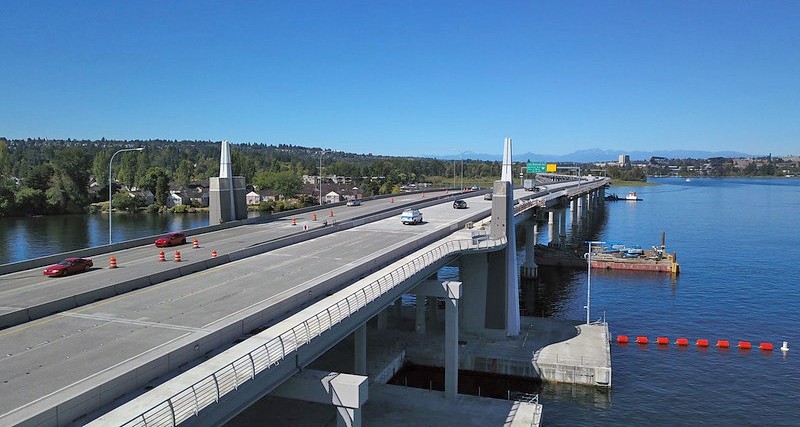While expansion joints are a necessary component of bridges, they also contribute to noise pollution. This study investigated the design and feasibility of strategies to mitigate noise caused by modular expansion joints on Washington state’s Evergreen Point Floating Bridge (SR 520 bridge) over Lake Washington.
Shortly after the SR 520 bridge opened in 2016, the Washington State Department of Transportation (WSDOT) began receiving noise complaints related to the large expansion joints on the east and west ends of the bridge. The noticeable impact of each car hitting the bridge’s modular expansion joints (MEJs) contributes to noise pollution in the area. While this specific bridge has received complaints since its opening, similar expansion joints across the state and beyond pose similar issues associated with noise. As requested by the Washington State Legislature, this study investigated the design and feasibility of strategies for mitigating noise caused by MEJs on the SR 520 bridge.
Bridge and viaduct expansion joints play a critical role by enabling the structure to move with changing environmental conditions. Bridge decks may be constructed with two or more isolated sections to ensure that expansion and contraction of the bridge due to changes in water level, temperature, wind, and currents do not cause damage. Room for expansion allows motion to occur without causing excessive stress in the bridge that can lead to failure. Expansion joints connect two isolated sections to provide a continuous pathway for travelers. Unfortunately, expansion joints also contribute to noise pollution. Several existing technologies reduce expansion joint noise, but these solutions also either require large-scale bridge renovation, fail to effectively reduce broadband noise, or require frequent maintenance.
The three main sources of noise from MEJs are resonance of the air within the gaps, resonance of the beams, and resonance of the tires. For this project, the researchers developed and fabricated a noise mitigation treatment to reduce tire deformation into the beam gaps and subsequently decrease pressure spikes on tires and beam edges. This treatment involved filling the gaps in the MEJs with flexible engineered chevron support structures.
Over a two-month test period, the chevrons installed in an MEJ in one lane of the SR 520 bridge proved to be highly effective. At a distance of 160 feet, the researchers consistently measured a greater than 4.51-dB broadband reduction in expansion joint noise. This accounted for more than a 70 percent reduction in expansion joint noise over the background noise of vehicles on the flat roadway. Beyond 160 feet the difference in noise between the flat roadway and the MEJ became so small that it was difficult to accurately measure.
Through this study, the researchers gained significant insight into the mechanism and practical mitigation of MEJ noise. They demonstrated that by filling the gaps in MEJs with flexible engineered chevron support structures, it is feasible to significantly reduce the noise from MEJs. The report also outlines further development and testing to extend the durability of the treatment.
Report: WA-RD 920.1
Authors:
Per Reinhall
Jeff Lipton
Sawyer Thomas
Waiel Elmadih
UW Department of Mechanical Engineering
Sponsor: WSDOT
WSDOT Technical Monitor: Mark Gaines
WSDOT Project Manager: Jon Peterson

